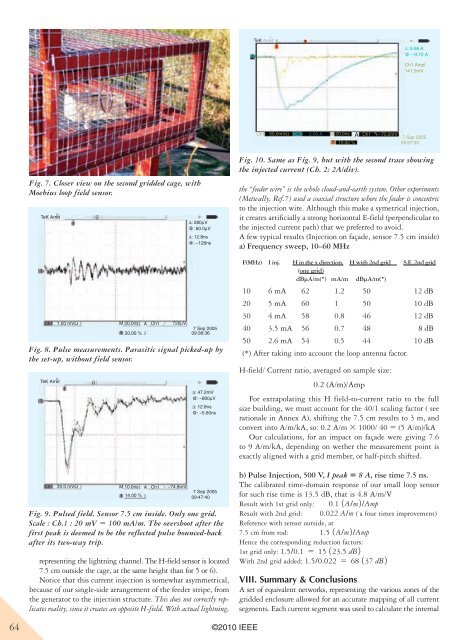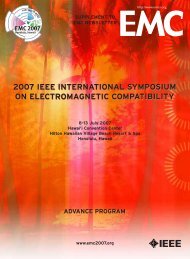Tutorial: EMC & Signal Integrity using SPICE, page 44 - IEEE EMC ...
Tutorial: EMC & Signal Integrity using SPICE, page 44 - IEEE EMC ...
Tutorial: EMC & Signal Integrity using SPICE, page 44 - IEEE EMC ...
You also want an ePaper? Increase the reach of your titles
YUMPU automatically turns print PDFs into web optimized ePapers that Google loves.
Fig. 7. Closer view on the second gridded cage, with<br />
Moebius loop field sensor.<br />
TeK Arret<br />
^<br />
1<br />
T<br />
Ch1 1.00 mVΩ M 20.0ns<br />
Fig. 8. Pulse measurements. Parasitic signal picked-up by<br />
the set-up, without field sensor.<br />
TeK Arret<br />
^<br />
1<br />
T<br />
T 20.00 %<br />
Ch1 20.0 mVΩ M 10.0ns<br />
T<br />
T<br />
T 14.00 %<br />
A Ch1 720µV<br />
A Ch1 –74.8mV<br />
∆: 280µV<br />
@: 60.0µV<br />
∆: 12.8ns<br />
@: –126ns<br />
7 Sep 2005<br />
09:38:36<br />
∆: 47.2mV<br />
@: –800µV<br />
∆: 12.8ns<br />
@: –5.60ns<br />
7 Sep 2005<br />
09:47:40<br />
Fig. 9. Pulsed field. Sensor 7.5 cm inside. Only one grid.<br />
Scale : Ch.1 : 20 mV 5 100 mA/m. The overshoot after the<br />
first peak is deemed to be the reflected pulse bounced-back<br />
after its two-way trip.<br />
representing the lightning channel. The H-field sensor is located<br />
7.5 cm outside the cage, at the same height than for 5 or 6).<br />
Notice that this current injection is somewhat asymmetrical,<br />
because of our single-side arrangement of the feeder stripe, from<br />
the generator to the injection structure. This does not correctly replicates<br />
reality, since it creates an opposite H-field. With actual lightning,<br />
64 ©2010 <strong>IEEE</strong><br />
2<br />
TeK Arret<br />
^<br />
T<br />
T<br />
Ch1 50.0mVΩ Ch2 2.00 A M 20.0ns Ch1 –75.0mV<br />
T 14.00 %<br />
Fig. 10. Same as Fig. 9, but with the second trace showing<br />
the injected current (Ch. 2: 2A/div).<br />
the “feeder wire” is the whole cloud -and-earth system. Other experiments<br />
(Metwally, Ref.7) used a coaxial structure where the feeder is concentric<br />
to the injection wire. Although this make a symetrical injection,<br />
it creates artificially a strong horizontal E-field (perpendicular to<br />
the injected current path) that we preferred to avoid.<br />
A few typical results (Injection on façade, sensor 7.5 cm inside)<br />
a) Frequency sweep, 10–60 MHz<br />
F(MHz) I inj. H in the x direction, H with 2nd grid S.E, 2nd grid<br />
(one grid)<br />
dBµA/m(*) mA/m dBµA/m(*)<br />
10 6 mA 62 1.2 50 12 dB<br />
20 5 mA 60 1 50 10 dB<br />
30 4 mA 58 0.8 46 12 dB<br />
40 3.5 mA 56 0.7 48 8 dB<br />
50 2.6 mA 54 0.5 <strong>44</strong> 10 dB<br />
(*) After taking into account the loop antenna factor.<br />
H-field/ Current ratio, averaged on sample size:<br />
0.2 (A/m)/Amp<br />
∆: 9.56 A<br />
@: –9.72 A<br />
Ch1 Ampl<br />
141.5mV<br />
7 Sep 2005<br />
09:57:33<br />
For extrapolating this H field-to-current ratio to the full<br />
size building, we must account for the 40/1 scaling factor ( see<br />
rationale in Annex A), shifting the 7.5 cm results to 3 m, and<br />
convert into A/m/kA, so: 0.2 A/m 3 1000/ 40 5 (5 A/m)/kA<br />
Our calculations, for an impact on façade were giving 7.6<br />
to 9 A/m/kA, depending on wether the measurement point is<br />
exactly aligned with a grid member, or half-pitch shifted.<br />
b) Pulse Injection, 500 V, I peak 5 8 A, rise time 7.5 ns.<br />
The calibrated time-domain response of our small loop sensor<br />
for such rise time is 13.5 dB, that is 4.8 A/m/V<br />
Result with 1st grid only: 0.1 1A/m2 /Amp<br />
Result with 2nd grid: 0.022 A/m ( a four times improvement)<br />
Reference with sensor outside, at<br />
7.5 cm from rod: 1.5 1A/m2 /Amp<br />
Hence the corresponding reduction factors:<br />
1st grid only: 1.5/0.1 5 15 123.5 dB2<br />
With 2nd grid added: 1.5/0.022 5 68 137 dB2<br />
Viii. Summary & conclusions<br />
A set of equivalent networks, representing the various zones of the<br />
gridded enclosure allowed for an accurate mapping of all current<br />
segments. Each current segment was used to calculate the internal<br />
A

















